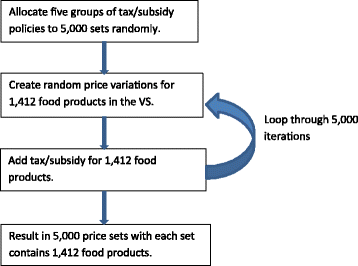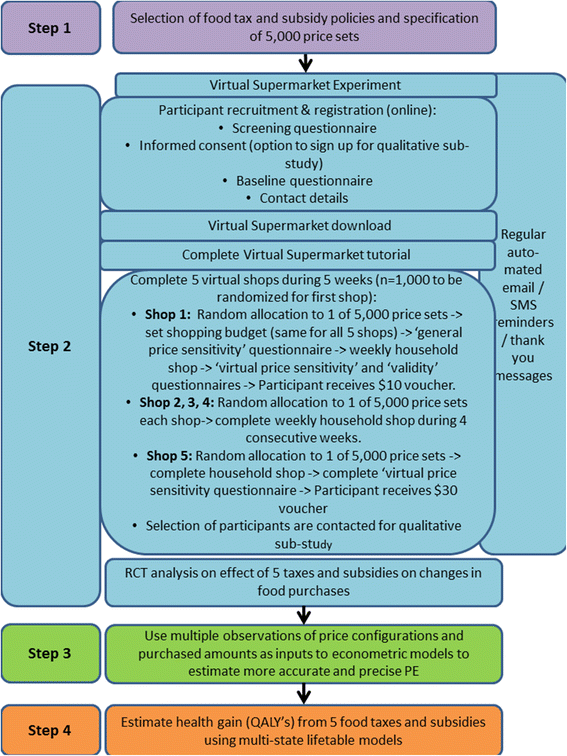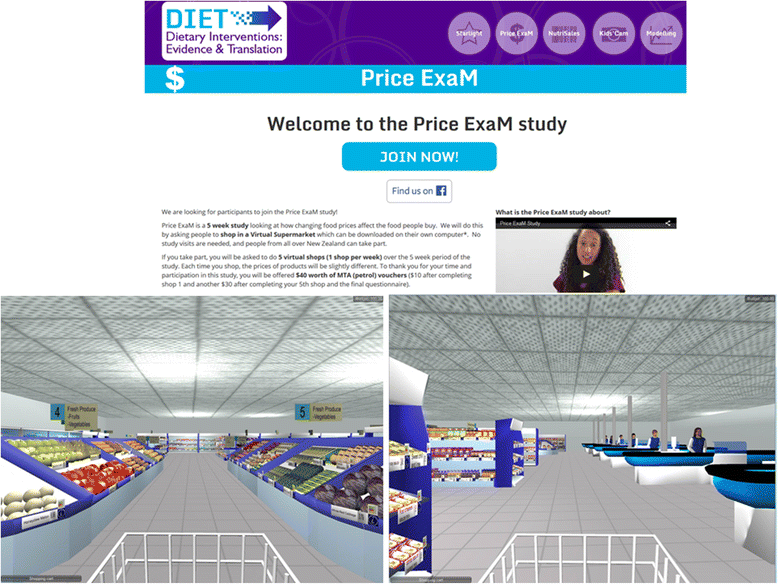Study protocol: combining experimental methods, econometrics and simulation modelling to determine price elasticities for studying food taxes and subsidies (The Price ExaM Study)
- PMID: 27435175
- PMCID: PMC4952230
- DOI: 10.1186/s12889-016-3277-5
Study protocol: combining experimental methods, econometrics and simulation modelling to determine price elasticities for studying food taxes and subsidies (The Price ExaM Study)
Abstract
Background: There is a need for accurate and precise food price elasticities (PE, change in consumer demand in response to change in price) to better inform policy on health-related food taxes and subsidies.
Methods/design: The Price Experiment and Modelling (Price ExaM) study aims to: I) derive accurate and precise food PE values; II) quantify the impact of price changes on quantity and quality of discrete food group purchases and; III) model the potential health and disease impacts of a range of food taxes and subsidies. To achieve this, we will use a novel method that includes a randomised Virtual Supermarket experiment and econometric methods. Findings will be applied in simulation models to estimate population health impact (quality-adjusted life-years [QALYs]) using a multi-state life-table model. The study will consist of four sequential steps: 1. We generate 5000 price sets with random price variation for all 1412 Virtual Supermarket food and beverage products. Then we add systematic price variation for foods to simulate five taxes and subsidies: a fruit and vegetable subsidy and taxes on sugar, saturated fat, salt, and sugar-sweetened beverages. 2. Using an experimental design, 1000 adult New Zealand shoppers complete five household grocery shops in the Virtual Supermarket where they are randomly assigned to one of the 5000 price sets each time. 3. Output data (i.e., multiple observations of price configurations and purchased amounts) are used as inputs to econometric models (using Bayesian methods) to estimate accurate PE values. 4. A disease simulation model will be run with the new PE values as inputs to estimate QALYs gained and health costs saved for the five policy interventions.
Discussion: The Price ExaM study has the potential to enhance public health and economic disciplines by introducing internationally novel scientific methods to estimate accurate and precise food PE values. These values will be used to model the potential health and disease impacts of various food pricing policy options. Findings will inform policy on health-related food taxes and subsidies.
Trial registration: Australian New Zealand Clinical Trials Registry ACTRN12616000122459 (registered 3 February 2016).
Keywords: Bayesian; Food policy; Food pricing; Food subsidies; Food taxes; Modelling; Price elasticities; RCT; Virtual supermarket.
Figures
Similar articles
-
The effect of food price changes on consumer purchases: a randomised experiment.Lancet Public Health. 2019 Aug;4(8):e394-e405. doi: 10.1016/S2468-2667(19)30105-7. Lancet Public Health. 2019. PMID: 31376858 Clinical Trial.
-
Taxes and Subsidies for Improving Diet and Population Health in Australia: A Cost-Effectiveness Modelling Study.PLoS Med. 2017 Feb 14;14(2):e1002232. doi: 10.1371/journal.pmed.1002232. eCollection 2017 Feb. PLoS Med. 2017. PMID: 28196089 Free PMC article.
-
The effect of food taxes and subsidies on population health and health costs: a modelling study.Lancet Public Health. 2020 Jul;5(7):e404-e413. doi: 10.1016/S2468-2667(20)30116-X. Lancet Public Health. 2020. PMID: 32619542
-
Evaluation of Economic and Health Outcomes Associated With Food Taxes and Subsidies: A Systematic Review and Meta-analysis.JAMA Netw Open. 2022 Jun 1;5(6):e2214371. doi: 10.1001/jamanetworkopen.2022.14371. JAMA Netw Open. 2022. PMID: 35648401 Free PMC article.
-
Food prices and obesity: evidence and policy implications for taxes and subsidies.Milbank Q. 2009 Mar;87(1):229-57. doi: 10.1111/j.1468-0009.2009.00554.x. Milbank Q. 2009. PMID: 19298422 Free PMC article. Review.
Cited by
-
Using household economic survey data to assess food expenditure patterns and trends in a high-income country with notable health inequities.Sci Rep. 2022 Dec 15;12(1):21703. doi: 10.1038/s41598-022-26301-z. Sci Rep. 2022. PMID: 36522384 Free PMC article.
-
Impact of taxes on purchases of close substitute foods: analysis of cross-price elasticities using data from a randomized experiment.Nutr J. 2021 Sep 7;20(1):75. doi: 10.1186/s12937-021-00736-y. Nutr J. 2021. PMID: 34493309 Free PMC article.
-
Using a UK Virtual Supermarket to Examine Purchasing Behavior Across Different Income Groups in the United Kingdom: Development and Feasibility Study.J Med Internet Res. 2017 Oct 9;19(10):e343. doi: 10.2196/jmir.7982. J Med Internet Res. 2017. PMID: 28993301 Free PMC article.
-
Using a Virtual Store As a Research Tool to Investigate Consumer In-store Behavior.J Vis Exp. 2017 Jul 24;(125):55719. doi: 10.3791/55719. J Vis Exp. 2017. PMID: 28784959 Free PMC article.
-
Modelling the health impact of food taxes and subsidies with price elasticities: The case for additional scaling of food consumption using the total food expenditure elasticity.PLoS One. 2020 Mar 26;15(3):e0230506. doi: 10.1371/journal.pone.0230506. eCollection 2020. PLoS One. 2020. PMID: 32214329 Free PMC article.
References
-
- Roberto CA, Pomeranz JL, Fisher JO. The need for public policies to promote healthier food consumption: a comment on Wansink and Chandon (2014) J Consum Psych. 2014;24(3):438–45. doi: 10.1016/j.jcps.2014.03.001. - DOI
MeSH terms
Associated data
LinkOut - more resources
Full Text Sources
Other Literature Sources




